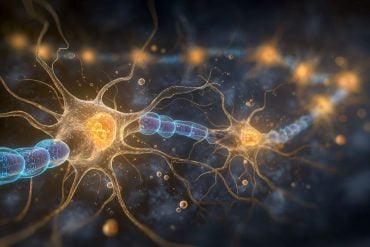Summary: A new study reveals that certain muscle proteins activated during exercise can increase the desire to stay active, shedding light on a muscle-brain signaling pathway.
The research suggests that this mechanism could play a crucial role in promoting regular physical activity, particularly in treating obesity and metabolic diseases. The findings also hint at the potential for developing targeted therapies to encourage exercise in those less inclined to do so.
Key facts
- Muscle proteins p38γ and p38α regulate the desire for physical activity through signaling to the brain.
- IL-15 protein, induced by p38γ, enhances spontaneous physical activity by acting on the motor cortex.
- Regular exercise boosts p38γ activity, especially in obese individuals, improving metabolism and reducing fat accumulation.
Source: Spanish National Cancer Research Center
Exercising is healthy, but not always appealing. Research led by Guadalupe Sabio from the National Cancer Research Center (CNIO) may have found a “switch” that activates the desire to get moving, as it shows that during exercise the muscle activates proteins which encourage further activity.
The paper is published in Science Advances.
“We have discovered how muscle itself regulates interest in exercise through a signaling pathway between muscle and brain that we didn’t know about, and which is one of those responsible—as there must be several—for the fact that, when we exercise, we experience the impulse to train even more,” explains Sabio, head of CNIO’s Interaction between Organs in Metabolic Diseases Group.

The article also shows that the proteins produced by muscle through exercise regulate each other. Thus, they prevent the desire to exercise from eventually harming the body.
The results are based on data obtained in animal models and also in humans (volunteers who performed controlled exercise, and patients with obesity). This suggests the identified signaling pathway “plays a crucial role in regulating physical activity in both mice and humans,” and “highlights the potential therapeutic significance of this pathway in treating obesity and metabolic diseases,” write the authors.
First co-authors of the study are Leticia Herrera and Cintia Folgueira, researchers at the National Center for Cardiovascular Research (CNIC).
Three proteins that influence the desire for physical activity
The group observed that when muscles contract repeatedly and intensely, due to exercise, the pathways of two proteins of the same family are activated: p38α and p38γ. Interest in physical activity is greater or lower depending on how much each of these two proteins is activated, the study shows.
There is also a third protein involved: interleukin 15 (IL-15). The authors observed that activation of p38γ by exercise induces the production of IL-15, and that this protein has a direct effect on the part of the cerebral cortex that controls movement, the motor cortex.
The increase of IL-15 in blood functions as a signal to the brain to enhance motor activity, which makes the animals voluntarily become more active.
“In this study, we revealed that exercise-induced activation of muscle p38γ leads to the production of IL-15, which subsequently enhances spontaneous physical activity. Furthermore, we observed the presence of this p38γ/IL-15 axis in humans after exercise, underscoring the clinical relevance of this signaling pathway in promoting exercise behavior within the population,” say the authors.
The effect of regular training
When animals were made to exercise on a regular basis, the activation of p38γ was also higher than that of p38α. This leads the research team to posit that training itself keeps the desire to exercise going.
In animals fed a high-fat diet and obese, regular exercise was beneficial: it improved metabolism and reduced the tendency towards diabetes and fat accumulation, especially in the liver.
In humans
In humans it was observed that both p38 proteins are activated in muscles that were exercised with an increasing intensity. A rise in IL-15 blood levels was also detected, with obese patients showing lower values.
This link with obesity is key, authors say, this disease being the most common metabolic disorder worldwide. Regular exercise is considered an effective strategy for both obesity prevention and treatment.
“The correlation between p38γ activation in human muscle during acute exercise and increased blood IL-15 levels highlights the potential therapeutic significance of this pathway in treating obesity and metabolic diseases,” write the authors in their paper.
A biomarker for the eagerness to train
For Sabio, one of the next steps will be to confirm that IL-15 is indeed a blood marker of the desire to exercise. Once this has been proved, “you would be able to study whether different types of exercises (weights, running, CrossFit…) stimulate this axis differently, and also if it has the same effect on obese and non-obese people. That can help coaches and personal trainers design their programs more efficiently.”
She adds that “we could even think about creating an IL-15 drug for people who are more in need of the positive effects of physical exercise, and less likely to do or maintain it. For example, people with obesity.”
Guadalupe Sabio is already planning to use this model to try to better determine the relationship between exercise, longevity and cancer and discover the mechanisms that regulate it.
About this genetics and exercise research news
Author: Guadalupe Sabio
Source: Spanish National Cancer Research Center
Contact: Guadalupe Sabio – Spanish National Cancer Research Center
Image: The image is credited to Neuroscience News
Original Research: Open access.
“Remodeling p38 signaling in muscle controls locomotor activity via IL-15” by Guadalupe Sabio et al. Science Advances
Abstract
Remodeling p38 signaling in muscle controls locomotor activity via IL-15
Skeletal muscle has gained recognition as an endocrine organ releasing myokines upon contraction during physical exercise.
These myokines exert both local and pleiotropic health benefits, underscoring the crucial role of muscle function in countering obesity and contributing to the overall positive effects of exercise on health.
Here, we found that exercise activates muscle p38γ, increasing locomotor activity through the secretion of interleukin-15 (IL-15). IL-15 signals in the motor cortex, stimulating locomotor activity.
This activation of muscle p38γ, leading to an increase locomotor activity, plays a crucial role in reducing the risk of diabetes and liver steatosis, unveiling a vital muscle-brain communication pathway with profound clinical implications.
The correlation between p38γ activation in human muscle during acute exercise and increased blood IL-15 levels highlights the potential therapeutic relevance of this pathway in treating obesity and metabolic diseases.
These findings provide valuable insights into the molecular basis of exercise-induced myokine responses promoting physical activity.






